It’s clear that the condition of post-war Japan was on Kurosawa’s mind during the years immediately following World War II. He didn’t shy away from it in One Wonderful Sunday, but that film featured a respectable working class couple. In Drunken Angel, Kurosawa almost literally dives into the cesspool of corruption and neglect of contemporary Japan.
That alone would have made Drunken Angel a notable film. But, Drunken Angel also marks the beginning of a great partnership. Susumu Fujita was unavailable to Kurosawa due to labor issues, so Kurosawa was looking for new actors. Toho Studios was looking at all sorts of new faces following the war, and one of the people trying out was Toshiro Mifune fresh out of the Army. Kurosawa didn’t discover Mifune, the credit goes to Kajiro Yamamoto, but Kurosawa was instrumental in getting Mifune hired when there was some debate on the board considering hiring Mifune. Mifune appeared in a couple of films before Drunken Angel, most notably Snow Trail which was written by Kurosawa and co-starred Takashi Shimura, but Drunken Angel was the film that made him a star, and Kurosawa and Mifune would be joined at the hip until Red Beard in 1965.
While One Wonderful Sundaywas a fairly candid look at the difficulties of post-War Tokyo, the gloves are really off for Drunken Angel. The opening shots center around a stagnant pond / cesspool in the heart of a downtrodden neighborhood which will form the central unifying image of the film. Prostitutes fan themselves by the side of the pond. A guitar player performs a tune in the night. Kurosawa tells us all we need to know and sets up some of the central themes without a word.
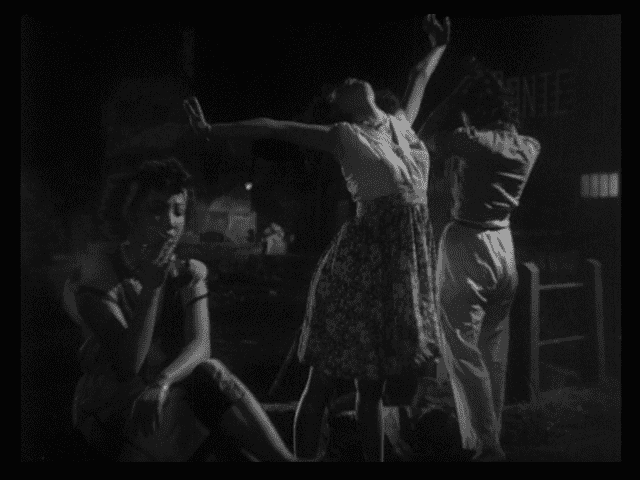
In this setting, the low level gangster Matsunaga (Toshiro Mifune) seeks out Doctor Sanada (Takashi Shimura) to address a wound to his hand. Mifune and Shimura will share the screen in a string of masterpieces and their first scene together crackles. Given how skinny Mifune is he’s not as immediately recognizable as he will be later, but his intensity is unmistakable. Matsunaga is arrogant, at least on the surface, and barely tolerant of Dr. Sanada. Perhaps rightly, as Sanada is established quickly as a doctor barely holding on, treating the lowest of the low, and drinking too much. The “drunken” part of the title is established, at least as backstory, early. Sanada’s marginal circumstances aren’t hidden though as he ends up performing surgery on Matsunaga’s hand without the assistance of anesthetic. Not that Sanada is all that unhappy about that fact.
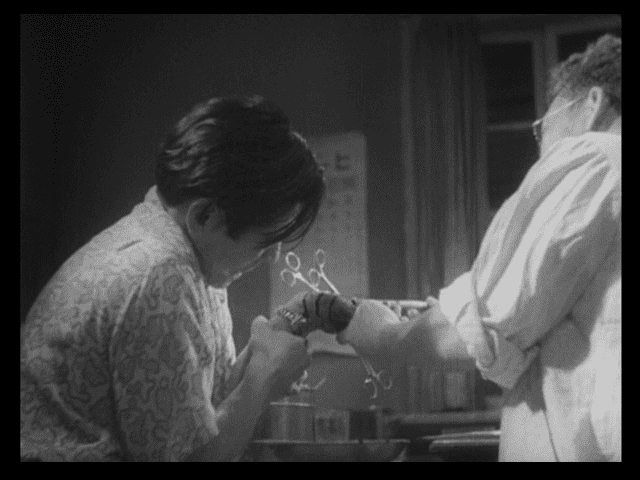
It’s an interesting contrast that’s set up early. Matsunaga displays nothing but confidence even though he has no higher purpose in life. Sanada, like his country, is disillusioned, cynical, and defeated despite the higher calling of his profession. But Sanada soldiers on and notes the signs of tuberculosis, which Matsunaga dismisses. Or at least tries to, as it’s clear he’s shaken to his core. So much so that he pays no attention to Sanada’s nurse Miyo (Chieko Nakakita) that his lackeys almost recognize.
The movie sticks with Sanada a bit, we follow him as he chases some kids from playing in the obviously contaminated cesspool. It’s a redeeming value that will elevate him from his drunkenness that he will try to save even the bad.
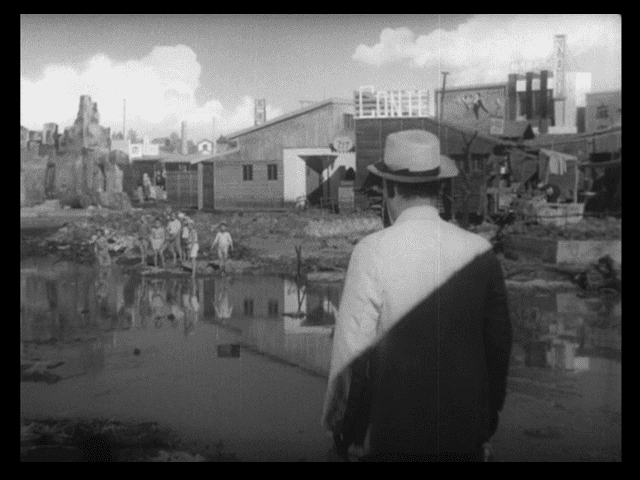
Kurosawa’s original intention was to concentrate the film on Sanada, but Mifune was a force of nature that demanded more attention. I think Drunken Angel is a better film as a result. By shifting the focus to concentrate more on Matsunaga the film expands in scope and stakes as we follow Matsunaga through the underworld. And Sanada’s pursuit of Matsunaga, to persuade Matsunaga to at least get an x-ray, brings Sanada into contact with his own temptations, alcohol. And, although it’s a serious film, it’s not humorless as Sanada displays a welcome willingness to flirt with the bargirl.
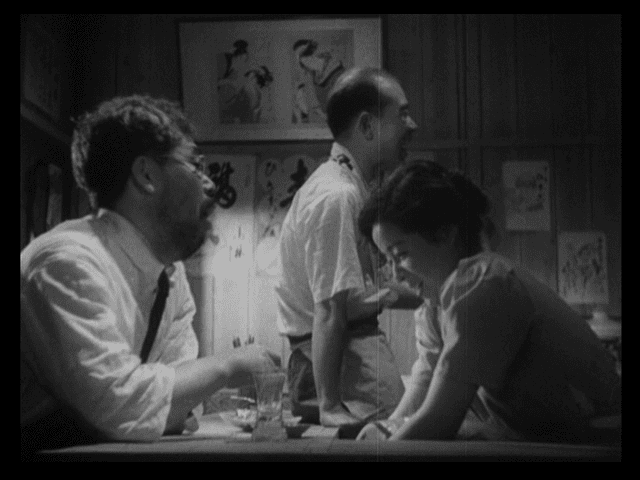
In an economy of character, the bargirl will prove of some importance later. The economy also helps makes a point, these characters are all connected into a community. It may not be a very reputable community, but it’s a community all the same. It’s just one with a large, contagious cesspool in the middle.
Meanwhile, Matsunaga is still behaving as if he’s bulletproof. Smoking, drinking, and whoring, he thinks because of his “status” as a yakuza he’s immune. Or perhaps he’s just too scared to admit it. Either way, we see that he thinks he’s a big shot and is full on acting that way.
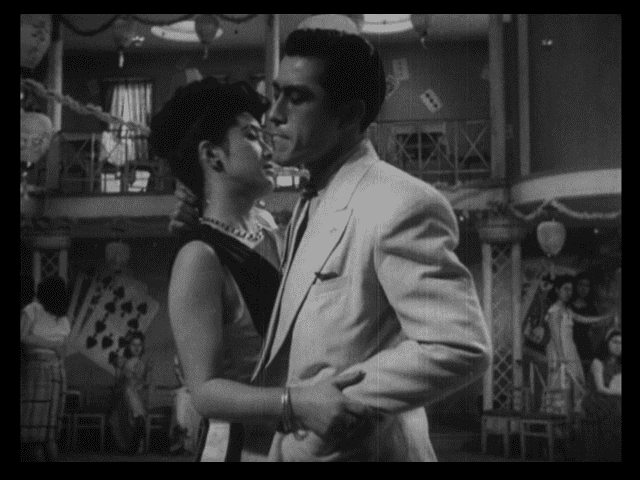
Sanada, we’ll learn, has had all the same vices in the past. And although he still drinks, a lot, he’s at least learned some humility. He’s at least now content to suck on a popsicle rather than smoke like Matsunaga. Of note, the area of vice that they’re in is covered in signs in English which is an efficient way around censorship restrictions. Kurosawa is smart that instead of just ducking in for a drink and a conversation once Sanada tracks down Matsunaga, Matsunaga wants to go to a less conspicuous place to discuss his mortality. It’s both a character move and a way to show Matsunaga in his native environment as the perceived cock of the walk. Kurosawa strives to achieve balance between his two leads. Once they arrive at their destination, there’s a funny sequence reminiscent of Stagecoach, of Sanada giving in to his temptations.
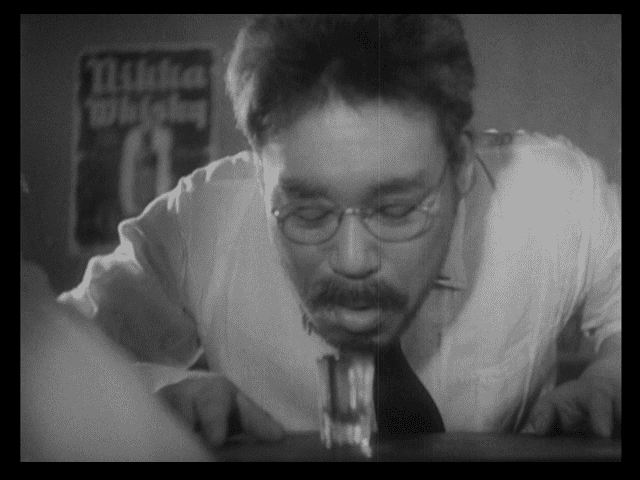
At this point, the two stalemate. Matsunaga can’t get Sanada to reveal why his nurse seems familiar. And Sanada can’t get Matsunaga to get an x-ray. Matsunaga argues that it’s his life to live. Sanada doesn’t argue that, but asks who cares if Matsunaga lives or dies? Sanada is just interested in killing TB, as his calling dictates. Matsunaga throws him out. It’s a good scene, not least of which because it quickly moves between moods comedic, dramatic, and angry. Kurosawa said that one of Mifune’s strengths as an actor was how quickly he could communicate what he’s thinking and feeling with the audience and that’s on full display in this scene. Shimura’s right there with him too.
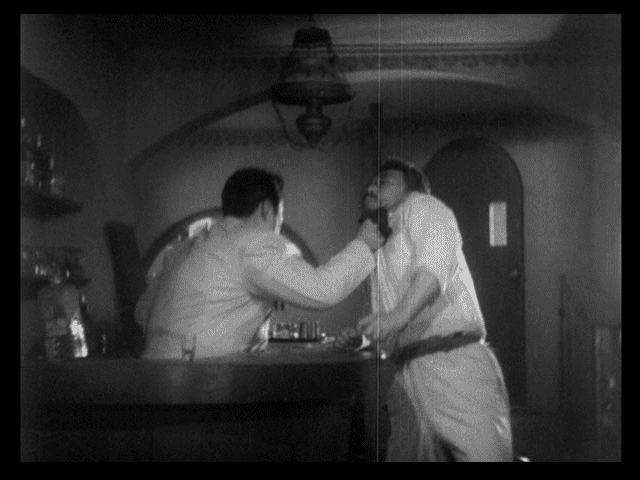
We’ve got a pretty full understanding of both men at this point. Or, at least, we think so, as Kurosawa has a few curveballs left. But, the stakes and characters are clear. Sanada really is trying to save Matsunaga from himself as much as from the TB. Matsunaga’s character is just as destructive as the bacteria.
And, in a scene of self reflection, Sanada admits to his own self destructive character. He has a great calling, he actually cares about medicine, but he’s short tempered, blunt, stubborn in addition to his vices. He could have been just as rich and successful as his classmates, but his character dragged him away from high society. Amusingly from the vantage point of history, he also scratches his head in frustration, a mannerism that will return in Seven Samurai. Sanada sees himself in Matsunaga, although he’d never admit it to Matsunaga but only to his nurse. Curing Matsunaga is like curing himself. The scene, like film noir, is filmed in heavy shadows adding to the sense of moral struggle. Into this an even darker note is added, as Sanada notes that Miyo’s former abusive boyfriend Okada (Reizaburo Yamamoto) is due to be let out of jail soon, although Sanada is confident that Okada will never find Miyo at the clinic.
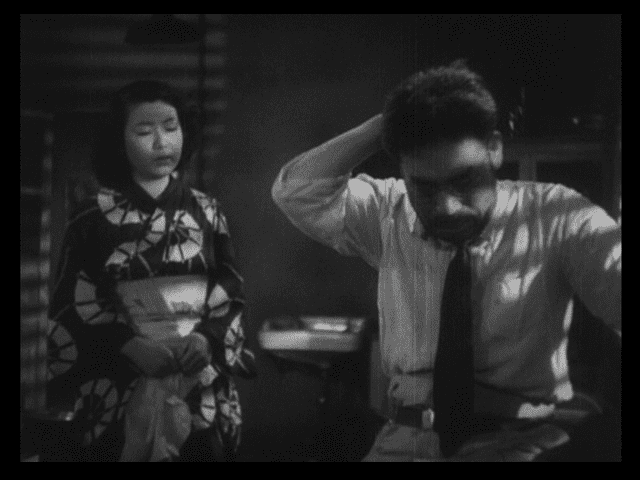
A dinner conversation continues the theme of Okada and how he abused Miyo. And, yet, there’s still an attraction. Sanada accuses her of thinking like a slave, but we’ve already been shown the seemingly glamorous attraction of the gangster lifestyle so it’s hard to blame Miyo too much. Scorsese will hit on this theme in Goodfellas. But, as Kurosawa seems to be saying, these are flawed human beings and it’s hard to live up to expectations. Again, the guitar player plays in the night, perhaps merely the Act I bookend. Perhaps indicating that things haven’t changed at all from the beginning of the film.
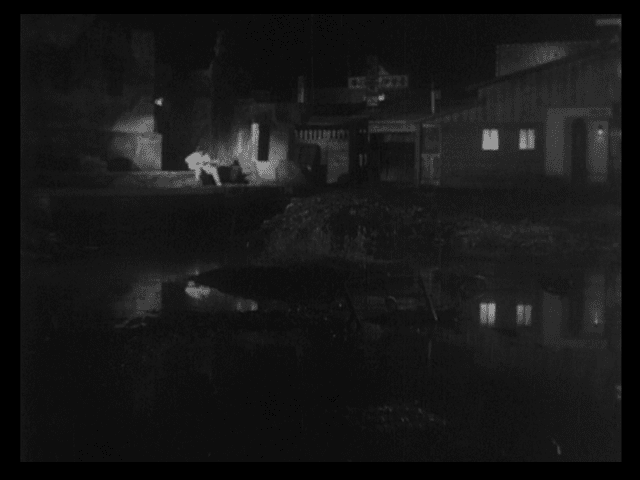
Things do begin to change from here though. First off, Kurosawa further comments on Matsunaga as Sanada deals with one of his patients, a young, teenage girl who’s also dealing with TB. It’s important to note that the girl displays courage, discipline, and optimism in that she’ll follow Sanada’s instructions and is confident she’ll beat the disease. A total contrast to the yakuza Matsunaga. More than that, it offers hope that Matsunaga can make the choice to live and this isn’t Ikiru where his fate is already established. Kurosawa follows up that consultation with Matsunaga visiting Sanada again. This time with Sanada accusing the yakuza of confusing embarrassment of being human with courage.
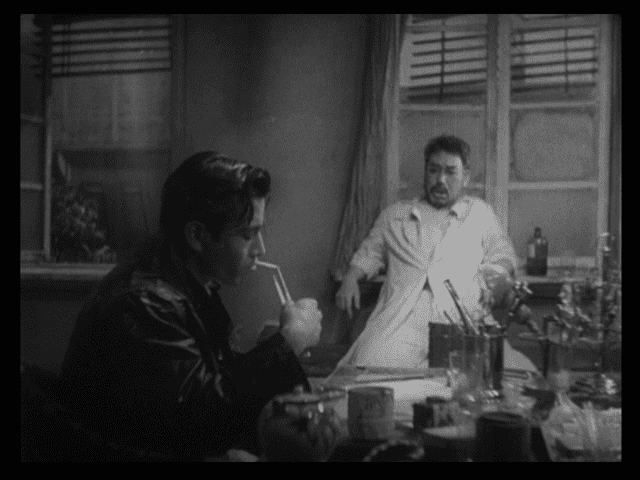
Kurosawa and Mifune make sure that this confrontation isn’t just one of talking. Mifune grabs a forceps off the table, examines it, and then uses it to smoke a cigarette right in the middle of the scene. It’s a scene stealing bit and perhaps signals the point where Mifune takes over the picture.
And he does from this point forward. There’s still some charades that goes back and forth between Sanada and Matsunaga, but Matsunaga does eventually get the x-ray taken and comes in the night to see Sanada. And Sanada is positive that they can cure him.
At this point, Okada enters. The guitar player is playing the same old tune, when Okada borrows the guitar and plays his own tune. It pretty much tells you everything when Okada is so bad that he even has his own theme song, “The Killer’s Anthem”. While Sanada and Matsunaga are nuanced characters, Okada is simply an agent of destruction. The yakuza personified. Playing that tune, Okada announces his return to the neighborhood. It’s a brilliant introduction using sound and image to bypass the usual grand entrance.
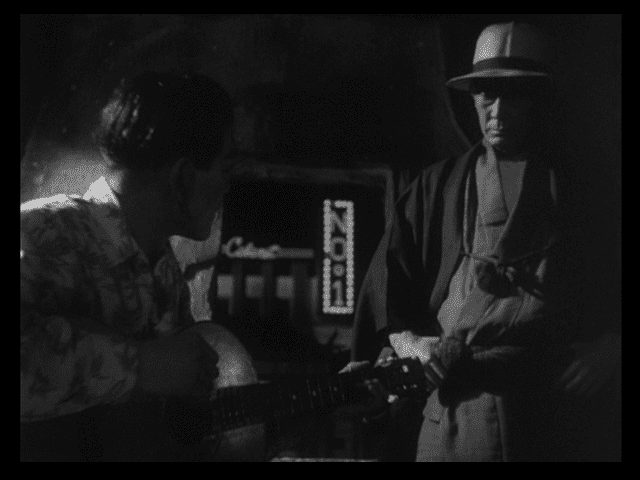
It’s not TB that will drive the rest of the movie so much as it’s Okada. He’ll drag Matsunaga into an unhealthy lifestyle undoing his progress in battling the disease. And he’ll hunt for Miyo even though he’s already moved in on Matsunaga’s girl. Sanada may represent rationality, even with his weaknesses, but Okada is pure rapaciousness.
It’s through Okada that Matsunaga will learn some hard lessons about his true place in the yakuza and how much they truly value loyalty and honor. And Matsunaga has all his illusions shattered.
In the end, Matsunaga has to make the big decision. Sanada, sensibly, decides that if Okada is going to cause problems, he’ll go to the police. Matsunaga with his feudalistic beliefs in honor and courage doesn’t have as clear a path. Go to the country with the bargirl who is the only one that will take him in once Okada has taken his place, be passive and let the police do the job, or fulfill his debt of honor to Sanada and attempt to kill Okada himself? Matsunaga, to no real surprise, attempts the heroic and foolish option. And, again, Kurosawa distinguishes himself. It’s not enough to have a knife fight, but a knife fight amidst buckets of spilled white paint creates an indelible image. Perhaps the Wachowskis were thinking of it for Bound.
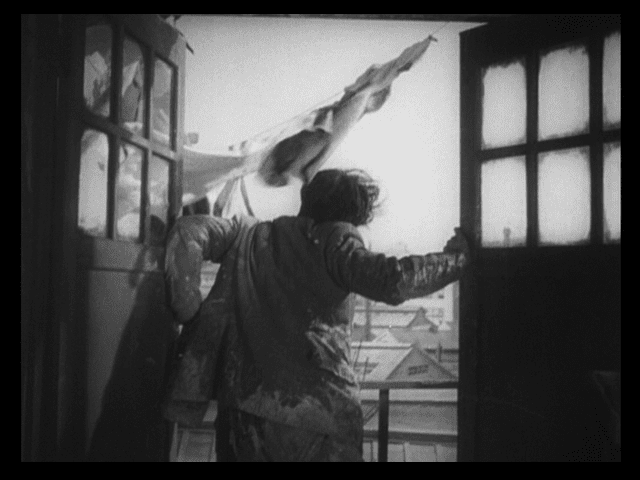
It’s a glorious climax. Although, in the end, it changes relatively little. There are two less yakuza around, either through flight, death, or prison –I won’t spoil it– but the cesspool is still right in the center of the neighborhood. But, perhaps there is hope for the future as Sanada’s schoolgirl patient comes back with a clean x-ray. Not everybody can be saved, but the rational and disciplined can.
There’s not much to criticize in the whole picture. Really, only two sequences stand out. Shortly after Okada and Matsunaga meet and celebrate Okada’s release from prison, into the seedy nightclub is thrown a glitzy musical number. It’s not necessarily bad, but it stands out like a sore thumb.
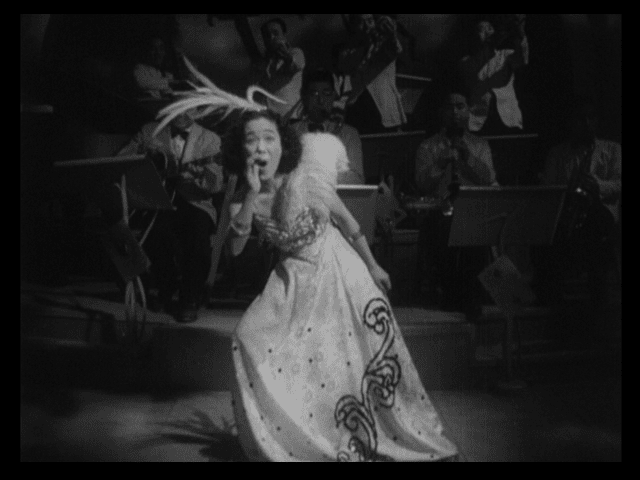
The other is less a flaw and more a stylistic choice that doesn’t quite fit in with the rest. In the midst of his struggle with his illness, Matsunaga has a dream where he confronts his own mortality. It’s a needed character moment, but it’s filmed in such a way that it’s reminiscent of Dreyer’s Vampyr more than Kurosawa’s so far gritty drama. Since it’s a dream it’s a legitimate choice, but it is a bit jarring.
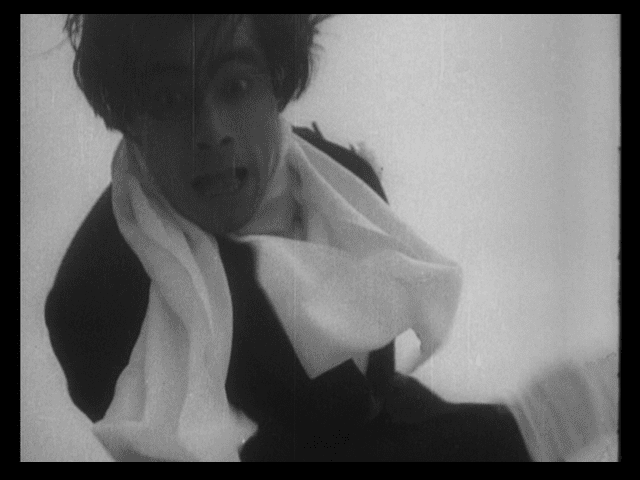
Drunken Angel is a minor masterpiece and complete unto itself. Kurosawa had made some terrific movies before, but his style for the next major phase of his career really cements itself here. No longer would the mentor be the flawless exemplar and the student’s path would be ever more difficult. The film is recognized as a great film immediately and created a new star in Mifune. Kurosawa hit every target he was aiming for, although he brushed aside Mifune’s struggle with the actual disease over Mifune’s struggle with his character and role in society. Perhaps sensing that there was more to be done, Kurosawa’s next film again featured Mifune struggling with disease.
Next Month: THE QUIET DUEL (1949)